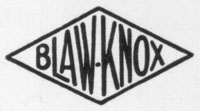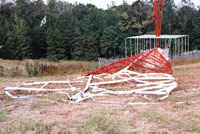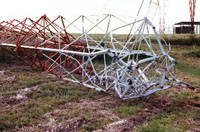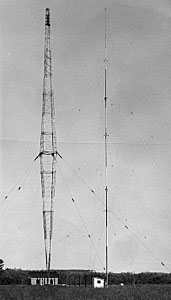| Accessed | times since March 19, 2001 |
| Accessed | times since March 19, 2001 |
The Blaw-Knox diamond tower is an icon of broadcast and architectural technology. The WLW page on this site has elicited many e-mails and much discussion as to how many towers of this type exist, where they all are and how long will they remain. Thanks to the many broadcast people who have contacted me and sent pictures and information on these towers, this page became possible. I have found some other sources of information on Blaw-Knox. I will update the page as I learn more. Blaw-Knox is now a product line name of Ingersoll-Rand paving and road surfacing equipment. Thanks to J.T. Anderton and Watt Hairston, who have contributed information to this page. Thanks also to J.T. Anderton, Ed Brouder, Kara Hairston, Ron Lawrence (W4Ron) and Mike Miranda for contributing photos, which appear on this page in addition to my own. I invite others with more information to me. - Jim Hawkins
|
On March 12, 1906 Blaw Collapsible Steel Centering Company was formed in New Jersey to manufacture and market re-usable steel forms for molding concrete in heavy construction. The initial product line of the Blaw company was based on the patented invention of Jacob B. Blaw of Philadelphia. This invention was for a better way to set the concrete for the sewers than by means of the wooden forms normally used for such work. In 1909 Luther Knox and Irvin F. Lehman became associated in the establishment of the Knox Pressed and Welded Steel Co. Luther Knox pioneered the use of pressed and welded steel, in place of previously used non-ferrous castings, for the manufacture of water-cooled equipment for open hearth furnaces and for other high temperature applications. The Blaw-Knox Company name was adopted July 6, 1917, marking the merger of Blaw Steel Construction Company with the Knox Pressed and Welded Steel Company. This merger introduced the company to the steel industry and also brought together the three Lehman brothers into one business firm. In 1927 the company added radio towers to its products. During its growth years Blaw-Knox acquired a number of companies. In 1929 A.W. French & Company became part of Blaw-Knox. This was a factor in eventually establishing a complete package of road-building equipment. Blaw-Knox is now a brand name of this equipment and is now part of Ingersoll-Rand. Blaw-Knox experienced less growth during the years of the Great Depression, but stayed in the black. The company was also involved in the manufacture of many products to support the efforts in WWII, such as: cast armor for naval vessels, turrets for tanks, anti-aircraft Bofors* gun mounts, Naval gun slides and mounts, rockets, projectiles, torpedo launching equipment and the operation of a 16-inch shell line, to name only a few. For it's excellence in the war effort, Blaw-Knox won seven Army-Navy "E" awards with 16 stars. The company served four basic market categories: (1) the metallurgical industries; (2) chemical process and nuclear industries; (3) public service industries; and (4) public works and highway construction industries. --- *Bofors is a Swedish company. One more note of interest is that Blaw-Knox built one of its early manufacturing facilities in Hoboken, PA. The town was renamed Blawnox, PA and is located next to Pittsburgh. (I was born in Hoboken, NJ)
The text contains far more details of acquisitions, people and various products, facilities, which are beyond the scope of this page. However, since the address was given in 1957, there is a gap of information which is needed to bridge to it's present part of Ingersoll-Rand. Also, I have yet to find historical information on the decisions and engineering, which led to the design and installation of this type of radio tower. Input is invited. ... Jim Hawkins |
 |
|
|
WADO - 1280, New York, NY 5KW (at the time) This tower was replaced and the station now runs at 50KW daytime. Height: 424' Photograph: Jim Hawkins |
|||
|
|
WBT - 1110 Charlotte, NC 3 in directional array Height: 428' each Photograph: Ron Lawrence - W4RON (I was informed that some people were cropped out of the photo. This photo is displayed as received.) |
|||
WFEA - 1370 Manchester, NH Heights: Taller of two towers in directional array, 350'(second tower is 199')
|
|
|||
|
|
WLW -700 Cincinnati, OH 50KW Height: 747' Photograph: Jim Hawkins |
|||
| WSM - 650 Nashville, TN 50KW Height: 808' Photograph: Kara Hairston |
|
|||
|
|
WCAU 1210 - Philadelphia, PA Photograph: Popular Science Mechanical Encyclopedia, March 1944 |
|||
| WBNS 1460 - Columbus, OH Photographed in 1998 |
|
"WHO in Des Moines had one until the late 1940's, when it was replaced at the same site by the existing
uniform cross-section tower. The bottom two-thirds of the old WHO tower was moved to the rear of an Iowa State
Police station in Des Moines for use as a communications tower.
These towers are a special part of radio history. I have visited all of them, and they do make quite a visual impression.
Most uniform cross-section towers all but disappear visually against many skyscapes, but not these. Their mass
stands out against any color of sky, often resulting in strong visual images. The WLW tower, with the call letters
lighted in white at the mid-way point, makes a strong visual impression, especially at twilight."
 |
This photo of the WBT towers was taken by J.T. Anderton. According to J.T., they remained in that state for a couple of months, while WBT ran on a one-tower special temporary authorization (STA)(10-kw non-DA, as he recalled). The towers were rebuilt exactly the way they were before the damage.
 |
 |
"I worked on air at WBT from 1985 till 1990 and it was a great time. I had listeners from Miami to Montreal, the ultimate ego trip! WBT has a rich history and takes considerable pride in that history. The WBT towers were designed when the station was on 1080. When they broadbanded the antenna system for AM Stereo they electrically shortened the towers with a fence that is perpendicular to the towers and runs around each one. The only place I have ever seen something like that." .... Mike Miranda
 |
||||
|
"electronics" magazine |
"electronics" magazine |
"electronics" magazine |
"electronics" magazine |
"electronics" magazine |
"electronics" magazine is a publication of the McGraw-Hill Publishing Company, Inc.
 |
"I finally figured out the origins of WFEA's mystery wooden tower. It was apparently built in 1933 or 34 to accomodate a power increase and a move from 1430 to 1340kc. It was half the height of the BK tower (which was referred to in print locally as "the third of its kind" in America). Between the two towers ran a rope from which a reflector was hung to protect WSPD in Toledo, Ohio. The wooden tower blew down in the hurricane of Sept. 1938 and was replaced within 3 months by a John Lingo 199 foot mast as pictured in the photo you have. The BK and Lingo sticks are still active today though the building is simply a ghost structure--transmitters but no people." Ed Brouder Man From Mars Productions |
Fabricated Steel
Fabricated steel, one of the principal products of Blaw-Knox Company, includes mill buildings, manufacturing
plants, bridges, crane runways, trusses and other construction of a highly fabricated nature.
A corps of highly trained engineers is maintained for consulting and designing services.
Transmission Towers
Four legged straight line or suspension towers, anchor and dead end towers, latticed and channel A-frames, river
crossing towers, outdoor sub-stations, switching stations, signal towers, steel poles, derrick towers.
We specialize in the design and fabrication of high tension transmission lines.
Plate Work
Riveted, pressed and welded steel plate products of every description, including: accumulators, agitators, water boshes, annealing boxes, containers, digesters, filters, flumes, gear guards, kettles, ladles, pans, penstocks, air receivers, stacks, standpipes, miscellaneous tanks, miscellaneous blast furnace work, etc.
Blaw Buckets
Clamshell buckets and automatic cableway plants for digging and rehandling earth, sand, gravel, coal, ore, limestone,
tin scrap, slag, cinders, fertilizers, rock products, etc.
For installation on derricks, overhead and locomotive cranes, monorails, dredges, steam,shovels, ditchers, cableways,
ships for handling cargo and coal, etc.
Blawforms
Steel form for every type of concrete construction: aqeuducts, bridges, cisterns,. Columns, culverts, curbs and gutters, dams, factories, floors, foundations, houses, locks, manholes, piers, pipe, reservoirs, roads, sewers, shafts, sidewalks, subways, tanks, tunnels, viaducts, retaining walls, warehouses, etc.
Furnace Applicances
Knox patented water-cooled doors, door frames, front and back wall coolers, ports, bulkheads, reversing valves,
etc., for Open Hearth. Glass and Copper Regenerative Furnaces: water-cooled standings, boshes and shields for Sheet
and Tin Mills.
Europe
Lisnargarvey, Northern Ireland built: 1936,
http://en.wikipedia.org/wiki/Radio_mast_Lisnargarvey
and
http://tx.mb21.co.uk/gallery/lisnagarvey.asp
Lakihegy, Hungary built: 1933, height: 314 metres,
Bernd Waniewski Page: http://www.waniewski.de/LW/Lakihegy/lakihegy_lw_1en.htm
http://en.wikipedia.org/wiki/Lakihegy_Tower and
http://en.structurae.de/structures/data/index.cfm?ID=s0016171
Vakarel, Bulgaria built: 1937, height: 352.9 metres, was at
completion second tallest tower of the world,
http://en.wikipedia.org/wiki/Vakarel_Transmitter
,
http://www.predavatel.com/bg/1/sof.htm#vak)
Stara Zagora, Bulgaria http://www.predavatel.com/bg/4/sta.htm
Submitted by Harold Lutz of Germany
Other Tower Pages
All images are Copyrighted and are provided for your personal enjoyment. Use of these images for commercial purposes including their distribution on CD-ROM or any other media without permission of the owner is prohibited.
Jim Hawkins